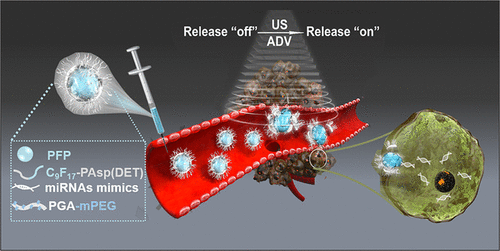当前位置:
X-MOL 学术
›
Mol. Pharmaceutics
›
论文详情
Our official English website, www.x-mol.net, welcomes your feedback! (Note: you will need to create a separate account there.)
Ultrasound-Assisted miR-122-Loaded Polymeric Nanodroplets for Hepatocellular Carcinoma Gene Therapy.
Molecular Pharmaceutics ( IF 4.9 ) Pub Date : 2020-01-07 , DOI: 10.1021/acs.molpharmaceut.9b00983 Huanling Guo 1 , Ming Xu 1 , Zhong Cao 2 , Wei Li 1 , Lida Chen 1 , Xiaoyan Xie 1 , Wei Wang 1 , Jie Liu 2
Molecular Pharmaceutics ( IF 4.9 ) Pub Date : 2020-01-07 , DOI: 10.1021/acs.molpharmaceut.9b00983 Huanling Guo 1 , Ming Xu 1 , Zhong Cao 2 , Wei Li 1 , Lida Chen 1 , Xiaoyan Xie 1 , Wei Wang 1 , Jie Liu 2
Affiliation

|
Ultrasound-induced microbubble sonoporation has been shown to effectively improve drug/gene delivery efficiency by enhancing tissue and cell permeability. However, the microscale size and short duration of ultrasound contrast agents limit their accumulation in target areas. Here, a kind of ultrasound-triggered phase-transitioning and size-changing cationic nanodroplet, perfluoropentane/C9F17-PAsp(DET)/miR-122/poly(glutamic acid)-g-MeO-poly(ethylene glycol) (PGA-g-mPEG) ternary nanodroplets (PFP-TNDs/miR-122), was developed to deliver microRNA-122 (miR-122) for hepatocellular carcinoma (HCC) treatment. PFP served as an ultrasound-sensitive core for ultrasound-triggered phase transition and size change from the nanoscale to the microscale. Positively charged C9F17-PAsp(DET) ensured adequate miRNA loading. PGA-g-mPEG, which served as the shell of the nanodroplet, modified the nanodroplets, enhanced their stability in serum, and protected miR-122 from degradation in vivo. The results exhibited that PFP-TNDs/miR-122 has a nanosize diameter (362 ± 15 nm) and remained stable for 24 h. After treatment with PFP-TNDs/miR-122 combined with ultrasound irradiation, the miR-122 expression level was significantly increased by approximately 600-fold in HepG2 cells, 500-fold in SMMC-7721 cells, and 30-fold in human HCC xenografts. Moreover, PFP-TNDs/miR-122 combined with ultrasound radiation effectively suppressed the growth, migration, and invasion of HCC cells, and inhibited tumor proliferation in mice. This study revealed that the biodegradable PFP-TNDs is a promising therapeutic gene carrier with functions of gene protection and effective gene delivery for clinical applications. Furthermore, PFP-TNDs/miR-122 associated with ultrasound irradiation may pave a new way to improve the prognosis of patients with HCC.
中文翻译:

超声辅助miR-122负载的聚合物纳米滴用于肝细胞癌基因治疗。
超声诱导的微泡声穿孔已显示可通过增强组织和细胞的通透性来有效提高药物/基因的递送效率。然而,超声造影剂的微米级尺寸和短持续时间限制了它们在目标区域中的积累。在这里,一种超声触发的相变变尺寸阳离子纳米液滴,全氟戊烷/ C9F17-PAsp(DET)/ miR-122 /聚(谷氨酸)-g-MeO-聚乙二醇(PGA-g -mPEG)三元纳米液滴(PFP-TNDs / miR-122)已开发出来,可为肝细胞癌(HCC)治疗提供microRNA-122(miR-122)。PFP用作超声敏感的核心,用于超声触发的相变和大小从纳米级到微米级的变化。带正电荷的C9F17-PAsp(DET)确保足够的miRNA负载。PGA-g-mPEG,用作纳米滴的壳,修饰了纳米滴,增强了其在血清中的稳定性,并保护了miR-122免受体内降解。结果表明,PFP-TNDs / miR-122具有纳米级直径(362±15 nm),并在24小时内保持稳定。用PFP-TNDs / miR-122结合超声辐照处理后,miR-122表达水平在HepG2细胞中显着增加约600倍,在SMMC-7721细胞中显着增加500倍,在人类HCC异种移植物中显着增加30倍。此外,PFP-TNDs / miR-122与超声辐射结合可有效抑制HCC细胞的生长,迁移和侵袭,并抑制小鼠的肿瘤增殖。这项研究表明,可生物降解的PFP-TNDs是一种有前途的治疗性基因载体,具有基因保护功能和有效的基因传递功能,可用于临床。此外,与超声辐射相关的PFP-TNDs / miR-122可能为改善HCC患者的预后铺平新途径。
更新日期:2020-01-07
中文翻译:

超声辅助miR-122负载的聚合物纳米滴用于肝细胞癌基因治疗。
超声诱导的微泡声穿孔已显示可通过增强组织和细胞的通透性来有效提高药物/基因的递送效率。然而,超声造影剂的微米级尺寸和短持续时间限制了它们在目标区域中的积累。在这里,一种超声触发的相变变尺寸阳离子纳米液滴,全氟戊烷/ C9F17-PAsp(DET)/ miR-122 /聚(谷氨酸)-g-MeO-聚乙二醇(PGA-g -mPEG)三元纳米液滴(PFP-TNDs / miR-122)已开发出来,可为肝细胞癌(HCC)治疗提供microRNA-122(miR-122)。PFP用作超声敏感的核心,用于超声触发的相变和大小从纳米级到微米级的变化。带正电荷的C9F17-PAsp(DET)确保足够的miRNA负载。PGA-g-mPEG,用作纳米滴的壳,修饰了纳米滴,增强了其在血清中的稳定性,并保护了miR-122免受体内降解。结果表明,PFP-TNDs / miR-122具有纳米级直径(362±15 nm),并在24小时内保持稳定。用PFP-TNDs / miR-122结合超声辐照处理后,miR-122表达水平在HepG2细胞中显着增加约600倍,在SMMC-7721细胞中显着增加500倍,在人类HCC异种移植物中显着增加30倍。此外,PFP-TNDs / miR-122与超声辐射结合可有效抑制HCC细胞的生长,迁移和侵袭,并抑制小鼠的肿瘤增殖。这项研究表明,可生物降解的PFP-TNDs是一种有前途的治疗性基因载体,具有基因保护功能和有效的基因传递功能,可用于临床。此外,与超声辐射相关的PFP-TNDs / miR-122可能为改善HCC患者的预后铺平新途径。


























 京公网安备 11010802027423号
京公网安备 11010802027423号